Ultraviolet UVC Air Scrubber Disinfection Sterilization Restore Air Commercial

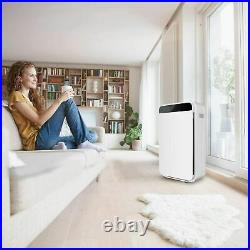
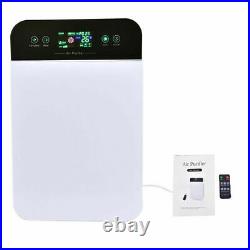
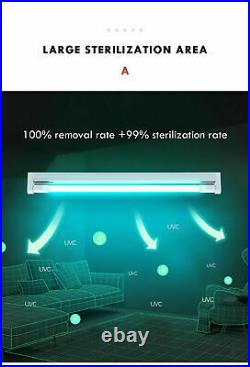
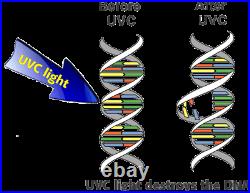

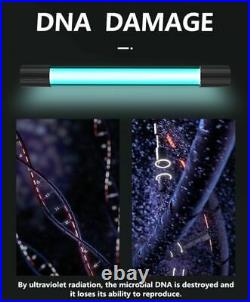
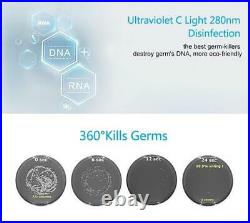
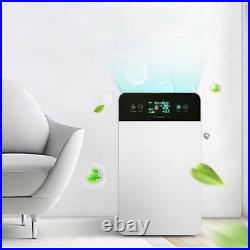
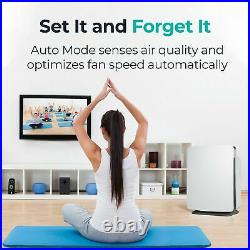
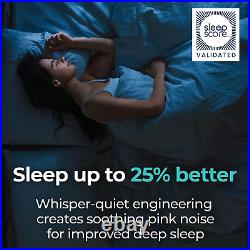



Filters do not purify the air; they simply capture Germs, Virus and Pathogens in one place. Left to their own devices, they build colonies. They make lots and lots of deadly colonies. You dont change filters because they are dirty. You change filters because they are loaded with some really nasty. Germs that are just sitting there waiting to escape back into the atmosphere. The answer is what Hospitals, Scientific Labs and Clean rooms utilize. It is called Ultraviolet Germicidal Irradiation or. You sterilize the filters the second the germs are captured. You do this by having a UV-C light at 254.7nm inside a crystal blown glass casing. Not cheap, but very effective. That is why we guarantee our light bulbs forever with a Lifetime Guarantee. Dont hold your breath as we have had one burning for three years and it is still going strong at 99% effective. A Clean Air Filter System without a UV light to Sterilize the Filters is no more effective than a fan blowing air throughout your room. Since bacteria are only one cell, they rely on their DNA to live. This is the principle behind UV light air purifiers. If a bacterial cells DNA is sufficiently damaged, it triggers a self-destruct mechanism, rendering it harmless. UV-C air purifiers can be installed in a wide variety of ways and to varying degrees of success. In one study, the placement of germicidal ultraviolet lamps on the walls of healthcare dwellings was found to successfully provide the disinfectant qualities with no statistically significant side-effects of UV overexposure, reinforcing the familiarity these systems have in the healthcare industry. How do UV air purifiers clean the air? The way UV-C light air purifiers work is quite simple. As discussed above, they are designed to use UV lamps that can potentially alter the DNA of microorganisms and inactivate or destroy them. Depending on the material of the emitter e. Phosphor or quartz, this light may be bluish or may not be visible to the human eye. Usually, residential units use mercury lamps that emit UV-C light at a wavelength of 254 nm. UV light air purifiers are generally a combination of a forced air system and another filter (like a HEPA filter). As a result, the UV light of the air purifier acts together with other processes to clean the air. Ambient, in-house air is forced through the unit and ventilated through a chamber with bulbs emitting light within the UV-C frequency. The UV lamp is usually placed downstream of a filter in a portable air purifier. Various factors such as the type of UV lamp, humidity and temperature can affect its performance. UV-C lamps used in UV-C germicidal purifiers are silent, and the glow of many, depending on the casing mounted around it, is invisible to the human eye. They are generally odorless. There has been little innovation in the air purifier industry until now. A new technology, UV-C Germicidal Air Scrubber technology, offers a powerful alternative solution over air purifiers. Not only does Air Scrubber technology destroy airborne microorganisms, it also. And allergens that air purifiers cannot address. For years, the air purifier Industry relied on Ozone to kill germs. They do indeed kill germs, but it also is dangerous to humans and animals above 5 parts per million. So dangerous that the Center for Disease Control issued a warning against using Ozone in a home based air purifiers. UV Light Chamber Labs. Air scrubber technology against highly resistant bacteria. The lab also tested the technology against viruses, mold and endospores. Results showed that air scrubber technology reduced concentrations of microorganisms by 99.999%. Unlike air purifiers that attempt to deactivate microbes, air scrubber technology can destroy them. Most importantly, the air scrubber process. As verified by an independent. Ozone emission test report. There is a huge difference between Sterilization and Sanitize air quality. Ultraviolet technologies destroy the air making the DNA of the Germs sterile thereby Sterilizing the entire colony. UV Air Filtration & Purification. Health experts agree that one of the best ways to promote long-term health is to keep indoor air pure and free of both particulate contaminates as well as germs, bacteria, and other microbes. Todays consumer is fortunate to have a wide variety of air purification systems to choose from, including air filters that more efficiently deal with microbial organisms than the air filters of years past. When it comes to choosing an air purifier and filtration system that will deal with these microscopic organisms, a filter that provides UV air purification may be the best choice to meet your needs. Ultraviolet Air Cleansing: The Basics. Unlike other air filtration systems that depend on HEPA filters or other devices to trap dust and other particles, UV air filtration uses state-of-the-art ultraviolet light technology to keep viruses and other microorganisms from reproducing and infecting a home, office, or other indoor space. Ultraviolet light damages the genetic material that controls the reproduction of these organisms, making it impossible for them to reproduce. This stops these illness-inducing microbes in their tracks and prevents the spread of various diseases and other problems. A UV light air purification system often combines a UV lamp with a traditional filter in order to maximize both the removal of particulate matter from the air and the killing of germs and bacteria. UV purification is most effective when the microorganisms have prolonged contact with the UV lamp. The longer that a virus or other organism is bathed in UV light, the greater the damage to its DNA and its ability to replicate itself. Furthermore, while an air purifier can be useful in reducing the spread of viruses and other microbes, an air filter system should be used in concert with other disease-prevention measures such as sterilization by use of UV-C Germicidal light. An Air Purifier is no replacement for the regular disinfection that occurs when one cleans a home or office with an UV-C air scrubber, but when used in concert, UV light purification can enhance any plan or system that is in place to reduce the spread of diseases. The Importance of Redundancy. Even the spacecraft that went to the moon had back up redundant air purification system aboard. Space and weight were critical but so was clean air. UV-C Germicidal light kills Germs, Virus and Pathogens on contact. Lab test results show 99.999% elimination of pathogens that can harm you, your family and even your family pet. Its that one in a million shot that requires fail safe redundancy. There are a few other methods that have proven to be effective in purifying the air. The ultimate unit combines all five methods into one unit. Lets look at the various methods besides UV-C Germicidal lights. The Ultimate Filtration uses all Five methods. Air filter purification traps airborne particles by size exclusion. Air is forced through a filter and particles are physically captured by the filter. Not unlike the air filter that is installed in your Air Conditioning System. Various filters exist notably including. How is carbon activated? Activated carbon is carbon that has undergone some additional processing to make it better at trapping gas molecules. First, it is injected with hot air, carbon dioxide, or steam, which creates a lattice of tiny pores in the carbon, vastly increasing its surface area. This creates many more places for molecules to become trapped and makes the carbon far more effective as a filter medium. By the Ohio Environmental Protection Agency notes that a single gram of activated carbon can have hundreds of square meters of internal surface area. Most activated carbon is also treated with a chemical that enhances its ability to filter specific pollutants. Activated Carbon is a lattice of carbon atoms connected to each other. The activation process is so important because the increase in surface area gives gases a greater area to stick to. When a molecule of some gaseous substance comes through the carbon, it can stick to the surface of the bed, provided there is an open adsorption site. High-efficiency particulate arrestance (HEPA) filters remove at least 99.97% of 0.3-micrometer particles and are usually more effective at removing larger particles. HEPA purifiers, which filter all the air going into a clean room, must be arranged so that no air bypasses the HEPA filter. In dusty environments, a HEPA filter may follow an easily cleaned conventional filter (prefilter) which removes coarser impurities so that the HEPA filter needs cleaning or replacing less frequently. HEPA filters do not generate ozone or harmful byproducts in the course of operation. Ionizer purifiers use charged electrical surfaces or needles to generate electrically charged air or gas ions. These ions attach to airborne particles which are then electrostatically attracted to a charged collector plate. This mechanism produces trace amounts of ozone and other oxidants as by-products. Most ionizers produce less than 0.05 ppm of ozone, an industrial safety standard. There are two major subdivisions: the fan less ionizer and fan-based ionizer. Fan less ionizer is noiseless and use little power, but are less efficient at air purification. Fan-based ionizers clean and distribute air much faster. Permanently mounted home and industrial ionizer purifiers are called electrostatic precipitators. Ultraviolet germicidal irradiation – UVGI can be used to sterilize air that passes UV lamps via forced air. Air purification UVGI systems can be freestanding units with shielded UV lamps that use a fan to force air past the UV light. Other systems are installed in forced air systems so that the circulation for the premises moves micro-organisms past the lamps. Key to this form of sterilization is the placement of the UV lamps and a good filtration system to remove the dead micro-organisms. For example, forced air systems by design impede line-of-sight, thus creating areas of the environment that will be shaded from the UV light. However, a UV lamp placed at the coils and drain pan of the cooling system will keep micro-organisms from forming in these naturally damp places. The most effective method for treating the air rather than the coils is in-line duct systems, these systems are placed in the center of the duct and parallel to the airflow. Air flow is vital. To remove the most pollutants possible from the air, the air needs to spend the maximum possible amount of time passing through the carbon. In the air filter industry, this is known as dwell time. A filter with a good amount of carbon of sufficient thickness and high dwell time is going to be far more effective than a filter with a thin layer of carbon. Volatile Organic Compounds (VOCs). Carbon air filters can be effective at filtering VOCs from the air. These are gaseous substances that most other mechanical filters like HEPA filters, cannot touch. Some of the gases in cigarette smoke or those given off by drying paint or cleaning products can be removed from the air by a carbon filter. Benzene, toluene, xylene, and some chlorinated compounds are among those that may be removed by carbon filters. Let us recap what we have discussed; the latest technology on the market is called Air Scrubbers. HVAC and the Air Conditioning Industry is bombarding the public with ads on installing ULTRAVIOLET lights in the ductwork of homes and hospitals to sterilize the air of germs, Virus and pathogens. It works, but very expensive. The average installation into youre A/C ductwork is around a thousand dollars and it is stuck there for life. The mobility of being able to move an air scrubber from room to room has enormous benefits. Being able to combine the best of the Air Purification Industry with the latest technological advances in science is a winner. Take the best of the past and combine it with the future and you have a winning combination. We all know about. They work if sufficient air movement goes through them. HEPA filters are in use in most Hospitals today. They should be in your home. ION generators have been used for years in the Fire and Smoke remediation Industry. They attack the particle and make them clean. Air Filters of course are found in every home to keep particles out of your air conditioning system and even used to filter the oil in your car. Ultraviolet germicidal irradiation UVGI has been used for years in hospitals to sterilize operating rooms, Instruments and sterilization of research labs. The 1903 Nobel Prize for Medicine was awarded for the use of UV light to cure Tuberculosis. Now put all five of these to work in one powerful system and you have a Germicide that destroys Germs, Virus and Pathogens all in one unit. It is the ultimate Destroyer of harmful DNA found in the most dangerous germ cells. The item “Ultraviolet UVC Air Scrubber Disinfection Sterilization Restore Air Commercial” is in sale since Sunday, June 7, 2020. This item is in the category “Home & Garden\Home Improvement\Heating, Cooling & Air\Indoor Air Quality & Fans\Air Purifiers”. The seller is “calex999″ and is located in Mesa, Arizona. This item can be shipped to United States.
- Features: Digital Display
- Manufacturer Warranty: 2 years
- Humidification Method: not applicable
- Custom Bundle: No
- MPN: not applicable
- Item Width: 12 in
- Voltage: 110 V
- Bundle Description: not applicable
- Item Height: 21 in
- Year Manufactured: 2020
- Model: UV Light Chamber
- Contaminants Captured: Allergens
- Item Weight: 10 lbs
- Filtration Technology: Activated Charcoal
- Application: Whole Room
- Power: 40 W
- Timer Control: 1 to 8 hours
- Brand: Pasteur Scientific Lab
- Color: White
- Energy Star: 10 Stars
- Filter Life: 18 months
- Item Depth: 8 in
- Type: Plug-In
